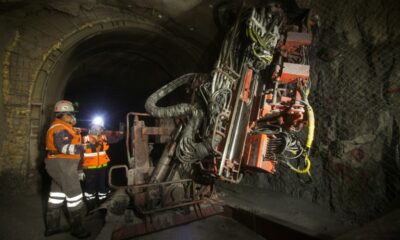The oil and gas sector has fallen behind other industries when it comes to digital transformation. Massive opportunity exists in technologies like cloud computing, the IoT and agile processes, but it remains to be seen whether the sector can adopt these tools in order to rapidly improve value throughout organizations.
Geoffrey Cann has worked as a consultant to oil and gas companies for 30 years. In his new book, Bits, Bytes, and Barrels: The Digital Transformation of Oil and Gas, Cann assesses how digital transformation is reshaping oil and gas, and how the industry can adopt technologies and processes to rapidly improve performance.
DX Journal interviewed Cann to find out where the oil and gas industry is currently in terms of digital transformation maturity, and what the industry needs to do to further embrace DX.
DX Journal: Has the oil and gas industry embraced digital transformation?
Cann: Oil and gas is among the least digitally switched on industries among the large industries. The role of autonomous tech is not high. Artificial intelligence isn’t as big as it is in other sectors.
The upstream industry is extremely data-intense. It generates untold quantities of data and they’ve been doing this for decades, so the industry has heaps and heaps of very large data sets. If you did a survey of companies that are buyers of supercomputers or have their own enormous data centres, oil companies would always be at the top of the list, because of this need to process subsurface data.
What’s happened is that the application of digital technologies is allowing the industry to go even deeper in resolution.
There’s a company in Calgary called Enersoft that’s taking a high-resolution photograph of drill cuttings and feeding the photographs into an artificial intelligence engine that can look at the photographs and can build up a completely new digital data set about an underground reservoir. They’re now able to model the underground data at the grain of sand level.
DX Journal: Can DX tech help oil and gas adapt to the competition from renewables?
Cann: As of yet there is no substitute for plastic and chemicals, which come from oil and gas. So there’s only a part of the industry that will have to change and cope with new alternative energy products.
The parts that do have to change are petroleum retailing and fuel distribution. The industry knows that there are serious clouds on the horizon when it comes to dealing with the rise of new alternative fuels. And it may come sooner than they think. Fuel delivery apps, shared vehicle services and autonomous vehicles are all serious threats.
DX Journal: Are there any tools these disruptive companies are using that oil and gas needs to embrace to better compete?
Cann: I’d say there are two tools. One is cloud computing. Oil and gas has not historically embraced cloud computing and there are still many people in the industry that cannot believe oil and gas should or will ever put its data into a third party cloud environment. They believe the data is proprietary and has intrinsic value. The idea that a third party could take your data, interpret it differently and then turn around and buy out your company is something so threatening that they won’t take the risk. In the face of banks putting all that customer data on the cloud, the CIA uses cloud computing — they still cling to this view.
Cloud will allow the industry to open up new business models that are right now very hard for them to get to. When you’re not on cloud, you’re siloed, you can’t swap data, can’t collaborate. Cloud changes that model up and it opens up new business models that they can’t otherwise get to. Cloud seems to be one of the key technologies to allow all the other creative inventions out there to really work. You go down the list: Google, Amazon, Netflix, Uber, Pinterest. These are all social technologies, but there’s no reason why the industrial sectors of the economy can’t take advantage of the same underlying technology.
The second thing they could do is not a technology, but it’s agile. The oil and gas industry runs on a traditional waterfall change model. And it is no longer in synch with the pace of change driven by digital innovation. The biggest benefit of agile is the ability of the oil and gas industry to change faster. In some industries, the transition from ideation to 50 percent market penetration is six years. And then you look at oil and gas, and from ideation to 50 percent market penetration is 30 years. It’s incredibly slow.
DX Journal: Thinking about the teams building DX, who should be leading this DX effort?
Cann: The successful introduction of technology into oil and gas requires leadership. The industry is very cautious and very risk-averse, and they adopt change very slowly. The industry has been extremely profitable over the years. When times are good, as they were from 2009 to 2014, a certain kind complacency sets in. A number of marginal improvements that Google would just leap on, oil and gas will say, no it’s just not worth the aggravation of having to adopt it, and we make so much money, it won’t change our economics by making something a little better. So the industry doesn’t embrace change very quickly.
Successful change does need very strong leadership from the company to demonstrate unyielding and relentless support to drive that change, in the face of these huge vectors that cement things in place and help them not change.
Leadership’s job is to lead, and they should be out in the field, communicating their vision, explaining to the field why change is important; explaining to them that the performance of the company is at stake if they don’t improve; holding people accountable if they don’t change; rewarding people that do change; answering their questions; supporting their supervisors. That’s what leaders are supposed to do.
DX Journal: Has anyone in the industry embraced that shift and developed digital transformation solutions?
Cann: NAL Resources Management Ltd. is an oil company owned by Manulife. In 2014, when the price of oil went down, NAL embarked on the usual playbook to fix the economics of the business. They went to the suppliers and asked for price concessions. They took a look at spending and cut back on anything that wasn’t urgent. They trimmed their dividend. They would have looked at their growth plan and slowed them all down. And they trimmed headcount. And they still weren’t going to be successful in the newly priced market.
The chief financial officer said, why don’t we try some of this new digital technology. They brought in three technologies and got them to work together. They brought in an artificial intelligence engine, to read contracts, a robot to build the calculations of the contract, and blockchain to take the calculations and autopay the recipients. NAL found a 90-95 percent productivity improvement over the status quo, enabling them to grow without adding headcount.
They’ve since had a steady stream of other oil companies contacting them to find out how on Earth they did this. The bot technology is being copied in a variety of places. Suncor has a whole bot team that does nothing but work on bots.
DX Journal: What is a career insight you’ve gained when it comes to DX that surprised you and that surprises people the most?
Cann: The biggest one is it’s not about technology, it’s about people. Most oil and gas companies think it’s the other way around, they think it’s about the technology, and they fear the technology. It’s not. It’s about engineering people and process change.
DX Journal: What’s the biggest mistake companies are making today when it comes to digital transformation?
There’s so many. I think the biggest mistake is underestimating the amount of attention and energy it’s going to take to work with people and move organizations to support the change.
And companies don’t often take a big enough view of what the technology could do for them. I’ll use NAL as an example. They brought in three technologies: artificial intelligence, bot technology and blockchain. What many companies would do is they would just trial artificial intelligence and then not get much of a payoff. They’d say, it’s a little faster than our people. They might put a bot in, and the bot would be faster than their people, but they’d say, well, it’s faster than our people, but we don’t want the headache of having to fire anybody. They might put blockchain in and then conclude, it’s not making any difference on how efficient we are. And they’d be correct in each instance, because they took such a narrow view of the problem they’re trying to solve.
I think the prize in the future is going to go to those organizations that embrace a bigger vision, and look much more holistically across about how to rethink the whole company, not just to dabble with a specific technology.
Cann’s new book Bits, Bytes, and Barrels: The Digital Transformation of Oil and Gas is available now in both paperback and Ebook format. Bulk purchases are available through direct correspondence with the author and an audiobook version is forthcoming.





 Business4 months ago
Business4 months ago
 Business4 months ago
Business4 months ago
 Events6 months ago
Events6 months ago
 People4 months ago
People4 months ago
 Events3 months ago
Events3 months ago












